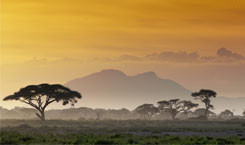African Coffees
Ethiopia is thought to be the birthplace of the earliest coffee known to mankind. A long history connects the country, its culture and its people to the fascinating beans. Today, Ethiopia and other African countries still cultivate coffee and are considered important growing regions producing excellent coffees.
Countries in East Africa like Ethiopia are mostly known for their Arabica production, featuring ideal conditions for the cultivation of the Arabica plants. Mountains, rain and mild climate conditions create productive plantations. In the center of the continent, both Arabica as well as Robusta beans are found and the vast flats of the African west feature Robusta plantations only. Together, the African countries produce about one sixth of the worldwide coffee production.
Because Africa is such a large continent featuring so many different environmental settings, it would be wrong to generalize the taste of African coffees. The hundreds of different climatic circumstances and variations of the Coffea-plant produce all kinds of coffee varieties, many of them known and valued for their outstanding quality.
Ethiopia
Ethiopia is the cradle of coffee. According to traditions and old stories, coffee first appeared here in the 9th century and was discovered by a Shepard. When roaming the Ethiopian countryside with his herd of goats, he noticed his goats becoming especially vivid whenever they were feeding on red cherries growing on dark green shrubs. Even though Ethiopia has many wild varieties of the Arabica plants, generally the mocha-variety is used for cultivation.
Although Ethiopia isn’t exactly a big player in terms of the amount of coffee produced, it is still the biggest coffee producer in Africa. About 90% of the raw coffee is grown on small, privately owned plantations. Both wet („washed“) and dry („natural“) processing of the beans are common in Ethiopia. Because of periods with intense drought and heat, the harvest has to be carried out on time in order to prevent the coffee cherries from dehydrating on the plants. Most of the Ethiopian coffee is harvested by hand.
The coffees of Ethiopia
With some of the worlds best coffees, Ethiopia inspires numerous coffee-lovers all around the globe. The Ethiopians know and love their coffee, the beverage is strongly integrated into the Ethiopian culture and everyone is proud of the coffee they create and happy to share it with the rest of the world. Thanks to a progressive course in agricultural politics and the aid of enthusiastically engaged micro-farmers, most of the Ethiopian coffee is ecologically farmed. This means, that the farmers do not use pesticides or herbicides. Because of this and because, Ethiopians usually don’t use additives when processing their coffee, this country puts forward some excellent coffees.
Ethiopian coffee is often considered especially fruity, containing usually well-balanced acidity and body and featuring interesting and unusual after-tastes as well many fine aromas. Because it is impossible to generalize or summarize the taste of all of these different coffees, it is definitely worth trying couple of these African highlights!
However, Ethiopian coffees usually have one thing in common: excellent taste. A pure Ethiopian coffee, which is even roasted in the country itself, is SOLINO coffee.
More Ethiopian coffees in our assortment e.g. Illy Etiopia.
Cameroon
It took a while for the coffee cultivation to reach Cameroon. Only at the beginning of the last century, the coffee plants were introduced to Cameroon by a German officer. The little country located in the central west of Africa mainly consists of highland plateaus. While the southern areas are covered in rainforests, the northern regions are pretty dry. Together with its mountains, Cameroon offers are wide variety of conditions for growing coffee. The slopes of mount Cameroon are covered in descendants of the famous Jamaican „Blue Mountain Coffee“ while the rest of the country mainly produces Robusta coffees.
Cameroon used to be the eighth biggest coffee producing country in the world. But after the government cancelled all substitutions in the eighties, coffee farming became a lot less attractive and the production stagnated. A lot of farmers adjusted to the far less demanding Robusta plants, producing only unexceptional coffee beans. The few Arabica areas still left in Cameroon are recognized all over the world though and the European Union is currently supporting the development of new Arabica cultivation areas with about 30 million Euros. Thanks to this aid, slowly but steadily the fair trade and eco standards are slowly being establishing too.
The coffees of Cameroon
At heights of up to 2000m, the northwestern slopes of mount Cameroon are home to fine Arabica plantations. The local tropical conditions with warm, steady temperatures all over the year and without frost provide an ideal habitat for the slightly more sensitive Arabica plants. Most of the coffee is harvested by hand because the slope areas of the mountains are inaccessible for vehicles and harvesting machines. The Arabica coffees of this area are described as pleasantly mild and sweet, tracing back to the sun-drying of the coffee cherries before washing them. Full and fruity to earthy Arabicas are usually from the tropical west of the country.
Greatly varying in quality, the Robusta coffees of Cameroon are of a uniquely nutty and powerful taste. Proficient growing conditions produce beans with a full body and intense flavors. Especially lately, some of the cooperatives started specializing in top quality Robusta beans, some of the best 100% Robusta blends, like the Caffe New York Camerun originated here, convincing with unusual aroma and flavor very different from Arabica coffees. Absolutely worth trying!
Tanzania
Coffee per se isn’t particularly popular in Tanzania itself. Only about 2% of the countries coffee production remain inside the country, the rest is exported. Brazil for example keeps a whopping 37% of its production for itself! Non the less, Tanzania has perfect conditions for the cultivation of coffee. Some of the farmers are aware of this and use their fertile lands to create exotic arabicas and high quality robustas.
Spontaneously, only a few word come into mind when we talk about Tanzania. Of course there is the Serengeti, Sanzibar, Kilimandscharo and Lake Vitoria but that is about it. Tanzania is actually covered in tropical rainforest near the coast, elevated plateaus and vast savannas. Especially the mountain sloped and the high savannas are being used for the cultivation of coffee because they receive sufficient downfall without ever experiencing frost. About 65% of the countries production consists of arabica coffee.
Only about 20% of the Tanzanian population has access to electrical power, the country has insufficient infrastructure and repeatedly struggles with hunger and disease. After gold, coffee is the most important export commodity of the poor country. Over all, about 70% of the population is working in the agricultural sector. Exporting coffee is one of the most valuable aids in developing the country because compared to gold, a lot more people benefit from coffee money. Because of the poor technical advancement of the country, Tanzanian coffee means one thing in particular: A lot of manual labor and the possibility to give this country hope and the chance to aid itself.
Tanzanian coffee
Often, Tanzanian coffees are compared to the high qualitative coffees of Kenya. Especially the top grade arabica coffees make their way to Europe more and more often most recently, convincing with their diverse flavors after being roasted in Europe. Fertile grounds create full-bodies aromas along with fruity acids and flavors of honey to nuts and wood. The popular bourbon variety of the arabica plant has been introduced to Tanzania, producing some very unique arabicas presenting fine vanilla flavors in the background.

